Nationalpark Jiuzhai-Tal - Eintrittspreise, Öffnungszeiten, Lage und Highlights
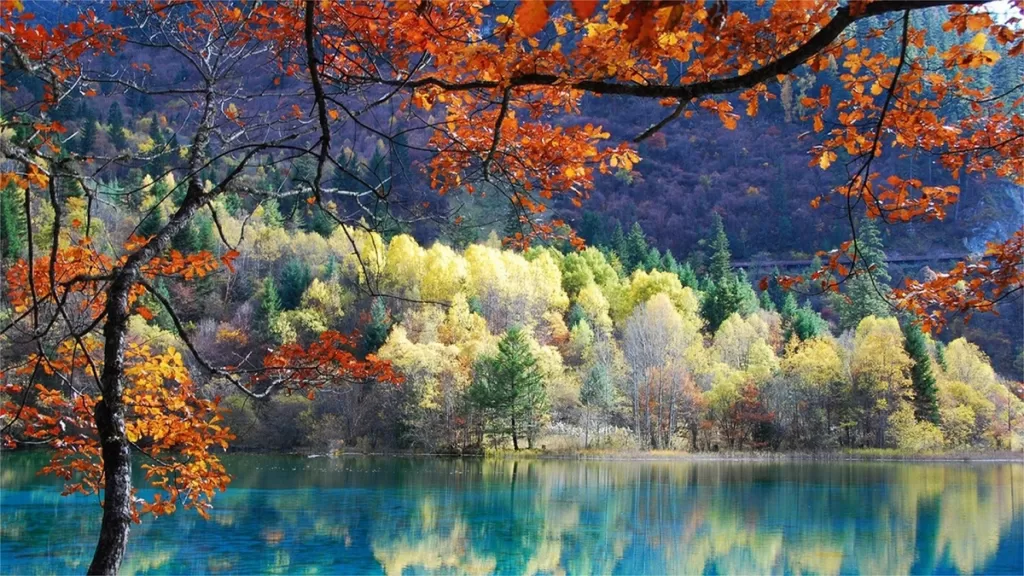
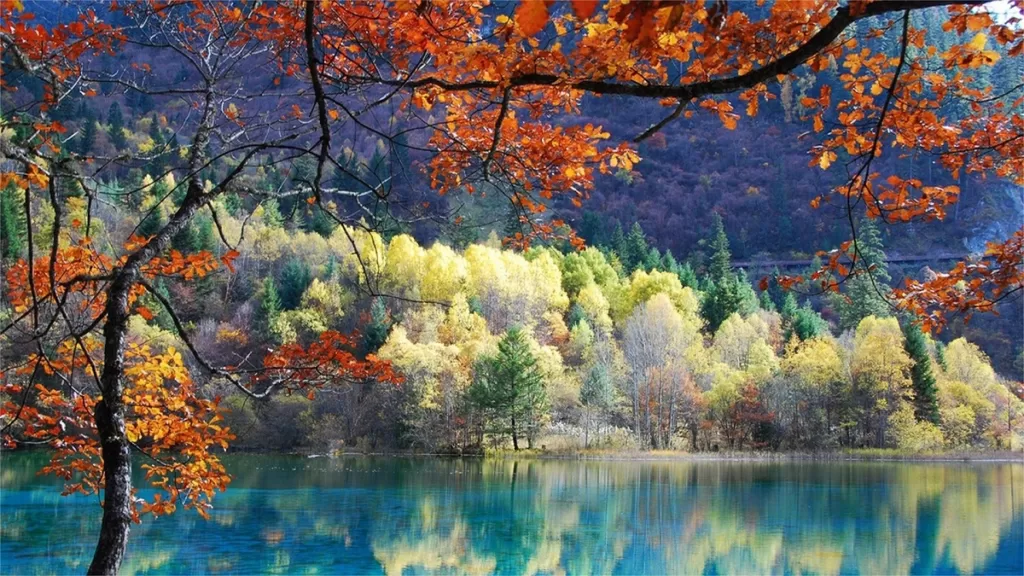
Jiuzhai Valley National Park (九寨沟, Jiuzhaigou) is a mesmerizing natural wonder located in the Aba Tibetan and Qiang Autonomous Prefecture of Sichuan Province, China. Spanning over 65,000 hectares, this enchanting park is renowned for its breathtaking landscapes and colorful lakes. Its name, “Jiuzhai,” translates to “Nine Villages,” reflecting the nine ancient Tibetan villages scattered throughout the valley.
The park is a sanctuary for diverse flora and fauna, including rare and endangered species like the giant panda and the Sichuan golden snub-nosed monkey. Visitors are captivated by the stunning turquoise, blue, and green hues of its numerous lakes, fed by crystalline waterfalls cascading down limestone terraces. Among the most celebrated are Nuorilang, Five-Flower, and Long Lake.
Jiuzhai Valley also boasts a rich cultural heritage, with indigenous Tibetan and Qiang communities preserving their traditional customs and lifestyle. Visitors can explore their unique architecture, handicrafts, and vibrant festivals.
With its unparalleled beauty and ecological significance, Jiuzhai Valley National Park has rightfully earned its status as a UNESCO World Heritage Site, inviting travelers to immerse themselves in a world of natural splendor and cultural enchantment.
Inhaltsübersicht
- Grundlegende Informationen
- Standort und Transport
- Highlights of Jiuzhai Valley national park
- Video about Jiuzhai Valley
- Empfohlene eintägige Reiseroute
- Nützliche Tipps aus echten Rezensionen
- Attractions near Jiuzhai Valley
Grundlegende Informationen
| Website | https://www.jiuzhai.com/ |
| Geschätzte Dauer der Tour | 1 - 2 Tage |
| Ticekt Price | 190 RMB per person (1st April – 15th November) 80 RMB per person (16th November – 31st March the next year) |
| Shuttle-Bus | 90 RMB (1st April – 15th November) 80 RMB (16th November – 31st March the next year) |
| Opeing Hours | 8.00 - 18.00 |
| Telefon Nummer | 0086-0837-7739753 |
Standort und Transport
Jiuzhai Valley is nestled in the northern part of Sichuan Province, China. It lies within the Aba Tibetan and Qiang Autonomous Prefecture, specifically in the Minshan Mountains on the eastern edge of the Qinghai-Tibet Plateau. The park’s geographical coordinates are approximately 33.25 degrees north latitude and 103.91 degrees east longitude.
To get to the valley, Tourists from Chengdu can first take a flight from Chengdu Shuangliu International Airport to Jiuzhai Huanglong Airport and then transfer to a coach to cover the remaining 85 kilometers (Other ways to get to Jiuzhai Valley from Chengdu).
Highlights of Jiuzhai Valley national park
Shuzheng Valley (树正沟)
Shuzheng Lakes (树正群海)

The Shuzheng Lakes are situated at an altitude ranging from 2,187 to 2,280 meters. This spectacular area consists of 19 interconnected lakes, formed through a combination of river valley deposition and calcium carbonate precipitation over millennia. The lakes cascade down the valley in a series of terraces, creating a stunning visual spectacle. The unique landscape here is characterized by a harmonious interplay of forests, lakes, and waterfalls, giving rise to the poetic description: “trees grow in the water, water flows through the forest, and people wander in a painting.” The crystal-clear waters of the lakes reflect the lush greenery and the surrounding snow-capped mountains, making it a photographer’s paradise and a serene escape for nature lovers.
Shuzheng Waterfall (树正瀑布)

Shuzheng Waterfall, perched at an altitude of 2,295 meters, is another highlight of the valley. This 11-meter-high and 62-meter-wide waterfall is notable for its distinctive convex shape, where the water cascades over multiple levels. The waterfall is formed by numerous smaller falls that merge together, creating a continuous, mesmerizing flow of water. The embankments around the waterfall are covered with resilient shrubs that have adapted to the constant barrage of water, forming a unique plant community and an extraordinary natural wonder. The sight and sound of the cascading water, coupled with the surrounding lush vegetation, offer a refreshing and invigorating experience for visitors.
Shuzheng Village (树正寨)
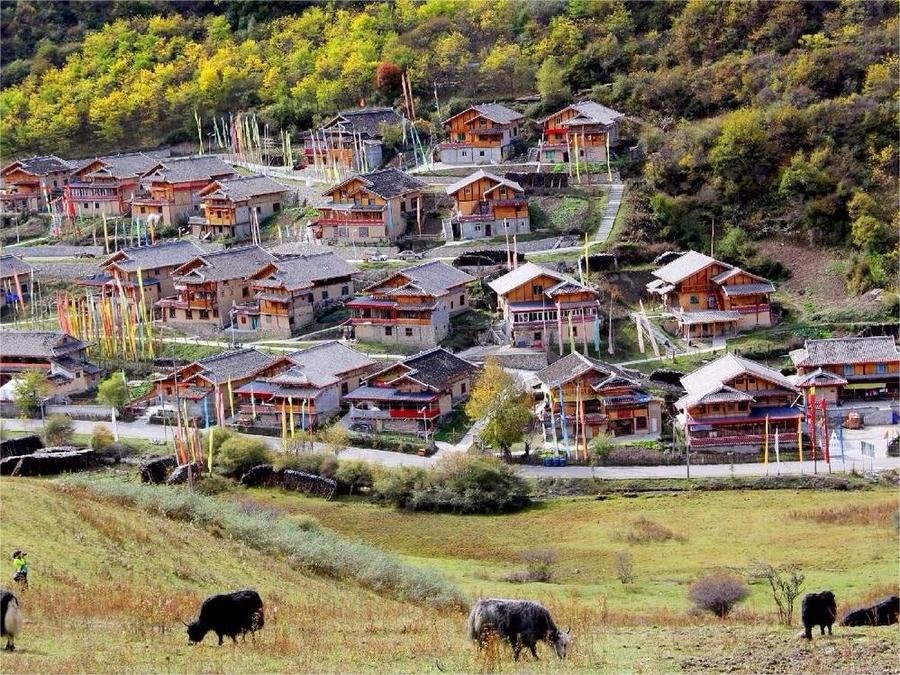
Nestled within Shuzheng Valley is Shuzheng Village, a traditional Tibetan and Qiang settlement. The village lies at the foot of the towering Dage Mountain, which rises to an altitude of 4,200 meters and faces the Shuzheng Lakes. Shuzheng Village is known for its Nine-Tier Lotus Buddhist Pagoda, symbolizing unity, peace, and happiness among the nine Tibetan villages in the region. The village also features a folk culture village, where visitors can admire the distinct Tibetan architecture, vibrant murals, and traditional Tibetan attire. The experience is enriched by the opportunity to observe and participate in the daily life of the Tibetan people, gaining insight into their unique customs, cuisine, and way of living.
Huohua Lake (火花海)

Huohua Lake, situated at an elevation of 2,211 meters, is a mesmerizing body of water stretching 294 meters in length and 232 meters in width, with a depth of 16 meters. The lake holds a volume of 450,000 cubic meters of water. It derives its name from the glittering effect created when sunlight dances on its surface, resembling flickering sparks. In 2017, a significant earthquake measuring 7.0 on the Richter scale struck Jiuzhaigou, causing the dam at the lake’s outlet to collapse. This resulted in a breach measuring 40 meters in length, 12 meters in width, and 15 meters in depth, leading to the temporary disappearance of the lake’s picturesque scenery. The earthquake also caused over 100 cracks to develop, the longest of which extended 50 meters with a width of 1 meter and a depth of 6.9 meters. After extensive research and planning, scientists used eco-friendly materials, such as calcareous deposits, fallen stones, and glutinous rice slurry, to repair the dam and cracks. This meticulous restoration work successfully prevented secondary disasters and reinstated the lake’s stunning appearance.
Reed Lake (芦苇海)
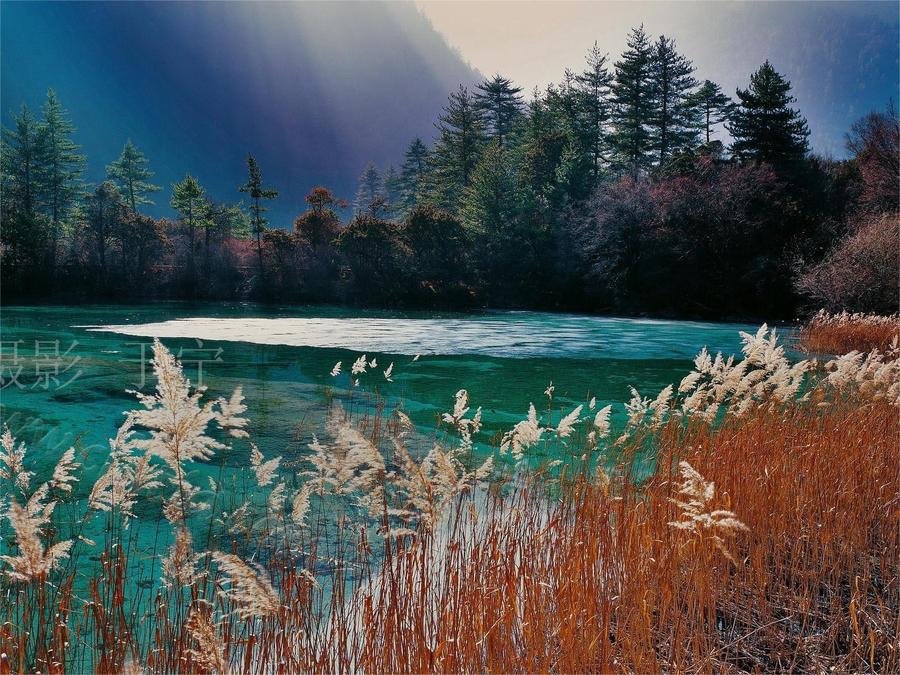
Reed Lake, located at an altitude of 2,192 meters, is renowned for its unique and tranquil beauty. The lake is approximately 15 meters high and 10 meters wide, situated opposite a limestone cliff on the eastern side. Over time, natural weathering and the growth of vegetation have sculpted the rock face into a serene and graceful image resembling a maiden’s profile. Local legend holds that this image is a representation of the goddess Woluo Semo, a revered deity in the folklore of Jiuzhaigou.
Bonsai Shoal (盆景滩)
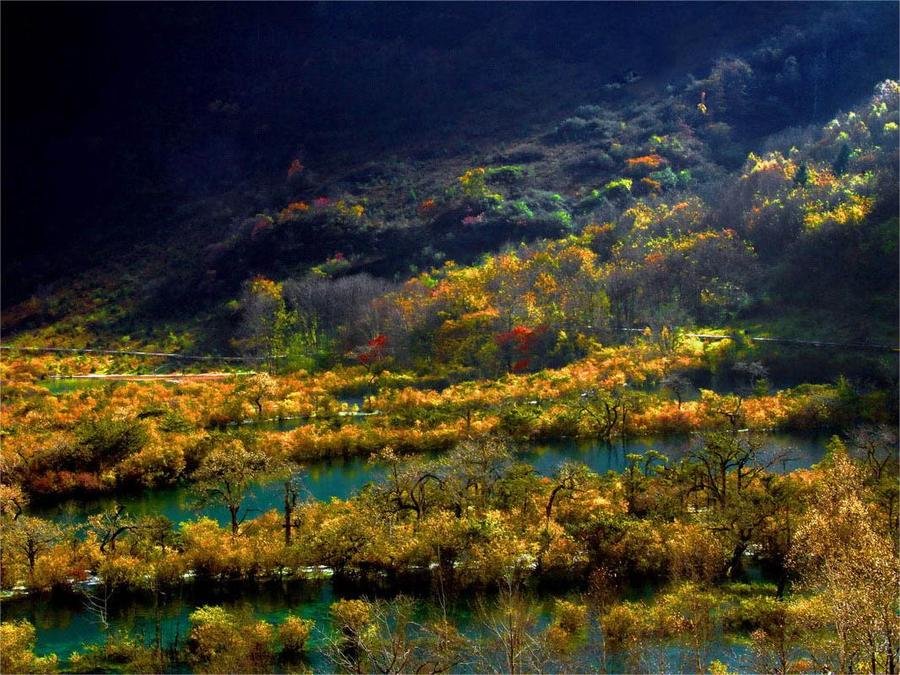
Bonsai Shoal, with an elevation of 2,190 meters, is a shallow stream landscape that marks the entrance to Jiuzhaigou. The shoal extends 218 meters in length and 98 meters in width, with a shallow depth of 0.8 meters. The area is characterized by a dense growth of willows, cypresses, poplars, pines, and rhododendrons, interspersed with various flowers and stones. The trunks of these trees are surrounded by calcareous deposits, forming natural embankments that rise slightly above the water’s surface, creating a scene reminiscent of a collection of miniature bonsai landscapes. This unique formation gives Bonsai Shoal its name and provides visitors with a delightful introduction to the natural wonders of Jiuzhaigou.
Wolong Lake (卧龙海)

Wolong Lake, sitting at an elevation of 2,220 meters, spans approximately 253 meters in length and 225 meters in width, with a depth of 24 meters. The lake is named after a calcified embankment on its bed that resembles a sleeping dragon. When the lake’s surface is calm, the dragon appears to be in deep slumber beneath the water. As a gentle breeze disturbs the surface, the dragon seems to stir, its body undulating with the ripples. Stronger winds create waves that make the dragon appear to awaken and thrash about, and in a fierce storm, the dragon seems to take flight, vanishing from sight.
Tiger Lake (老虎海)

Tiger Lake, located at an altitude of 2,298 meters, measures 310 meters in length and 194 meters in width, with a depth of 23 meters. During late autumn, the surrounding forest’s vibrant colors reflect in the clear waters, creating a pattern reminiscent of a tiger’s stripes. The mirrored hues of the red, yellow, and orange foliage combined with the clear blue water give the lake its name and offer a breathtaking view, especially when the colors are at their peak.
Rhinoceros Lake (犀牛海)
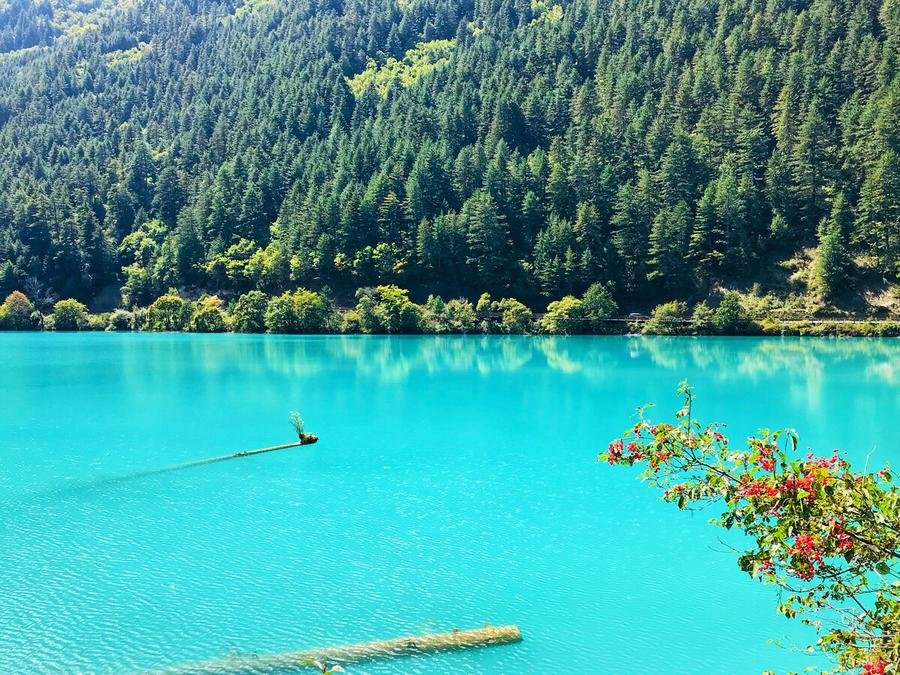
Rhinoceros Lake is the second largest lake in Jiuzhaigou, positioned at 2,301 meters above sea level. It stretches 2,000 meters in length and 225 meters in width, with a depth of 17 meters. The lake is named after a legend of a sickly monk who rode a rhinoceros to the lake, drank from its magical waters, and was miraculously healed. The monk left his rhinoceros behind, hence the lake’s name. In spring and summer, the lake’s waters are a vibrant green, while in autumn, the reflection of the colorful foliage on the water enhances the scenery, making it even more stunning than the reality.
Double Dragon Lake (双龙海)
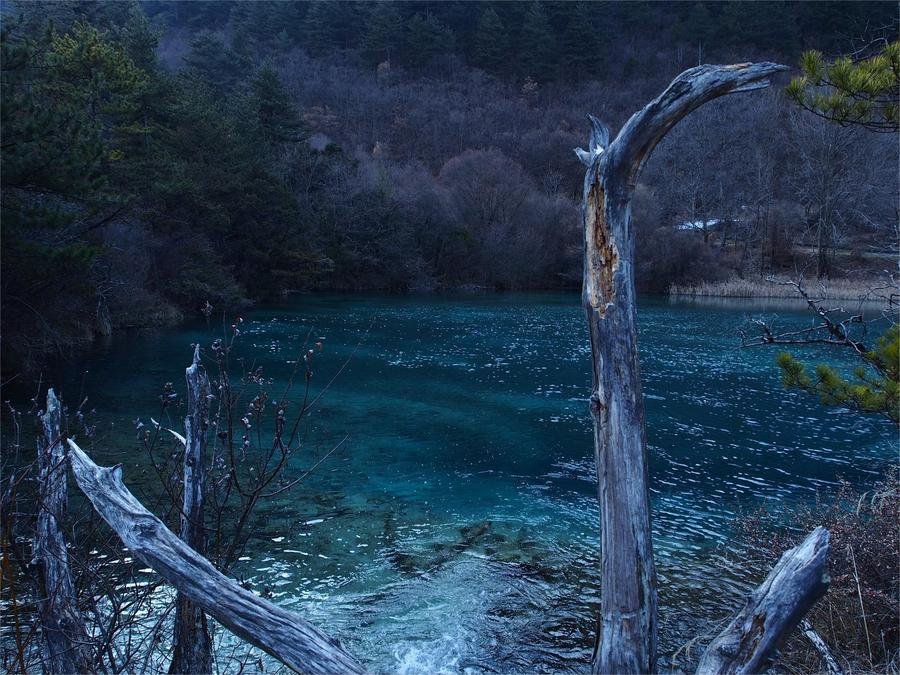
Double Dragon Lake, at an altitude of 2,200 meters, measures 290 meters in length and 247 meters in width, with a depth of 9 meters. Beneath the crystal-clear water, two calcified embankments resemble twin dragons. These natural formations consist of calcified deposits on top and glacial till at the bottom, giving the impression of two dragons lying in wait. The sight of these submerged dragons, seemingly alive and moving, adds a mythical allure to the lake.
Zechawa Valley (则查洼沟)
Seasonal Lakes (季节海)
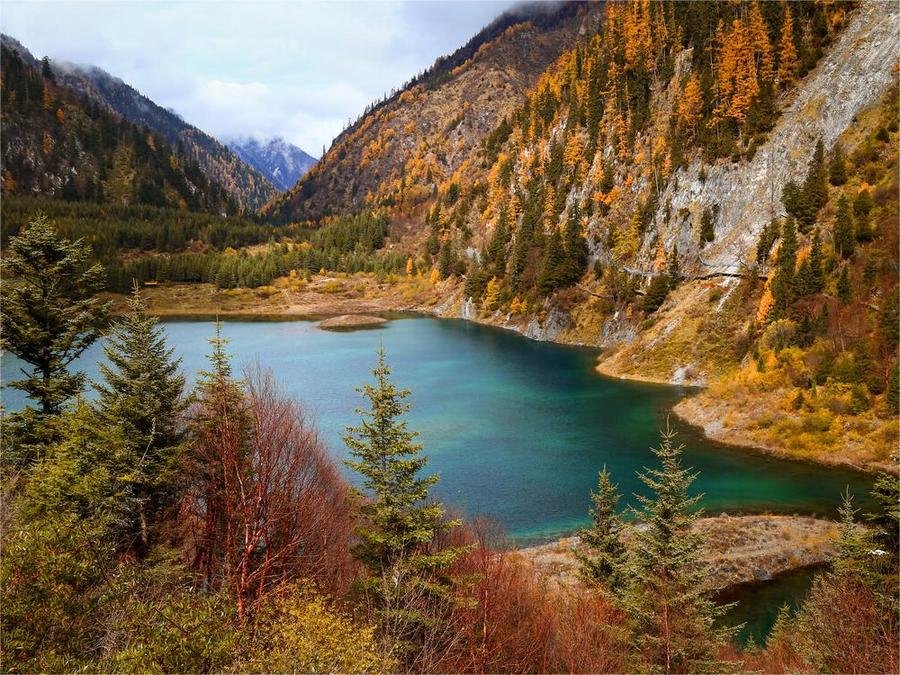
The Seasonal Lakes are a fascinating feature of Zechawa Valley. Positioned at an elevation of 2,910 meters, the Upper Seasonal Lake stretches 680 meters in length, 200 meters in width, and has a depth of 3 meters. This glacial barrier lake exhibits significant variations in water levels with the changing seasons, which is how it earned its name. During the rainy season, the lake fills with water, creating a picturesque scene. However, for much of the year, the lake bed dries up, transforming into a lush meadow covered in green grass.
The Lower Seasonal Lake, located at an elevation of 2,627 meters, also experiences seasonal changes. Formed by landslides and debris flows blocking the valley, this lake is most vibrant in October when rainfall is abundant, and the lake is full, displaying a deep blue hue. In early summer, as the water level decreases, the lake’s color shifts to a vivid green, showcasing a different but equally captivating appearance.
Five-Color Pond (五彩池)

The Five-Color Pond, situated at an elevation of 3,010 meters, measures about 100 meters in length, 60 meters in width, and 6.6 meters in depth. Despite being the smallest lake in Jiuzhaigou, it is often considered the most striking, earning the nickname “the Eye of Jiuzhaigou.” The lake’s water is replenished by underground sources, ensuring it never freezes, even in winter. The vibrant colors of the pond are the result of a combination of sunlight, algae, and calcified deposits, which create a mesmerizing palette of blues, greens, and purples that captivate visitors year-round.
Long Lake (长海)

Long Lake is the highest and largest lake in Jiuzhaigou, located at an elevation of 3,101 meters. It extends approximately 4,350 meters in length, 300 meters in width, and reaches a depth of 90 meters, with a volume of 45 million cubic meters. This glacial barrier freshwater lake, shaped like an “S” from a bird’s-eye view, is renowned for its depth and expanse. The lake has no visible outlet; its waters seep through underground fissures, eventually resurfacing to feed other scenic spots like the Five-Color Pond and the Five-Flower Lake downstream. Known as the “Treasure Gourd,” Long Lake never overflows during the rainy season and does not completely dry up during the dry season, maintaining a delicate balance that sustains the park’s ecosystem.
Rize Valley (日则沟)
Pearl Shoal Waterfall (珍珠滩瀑布)
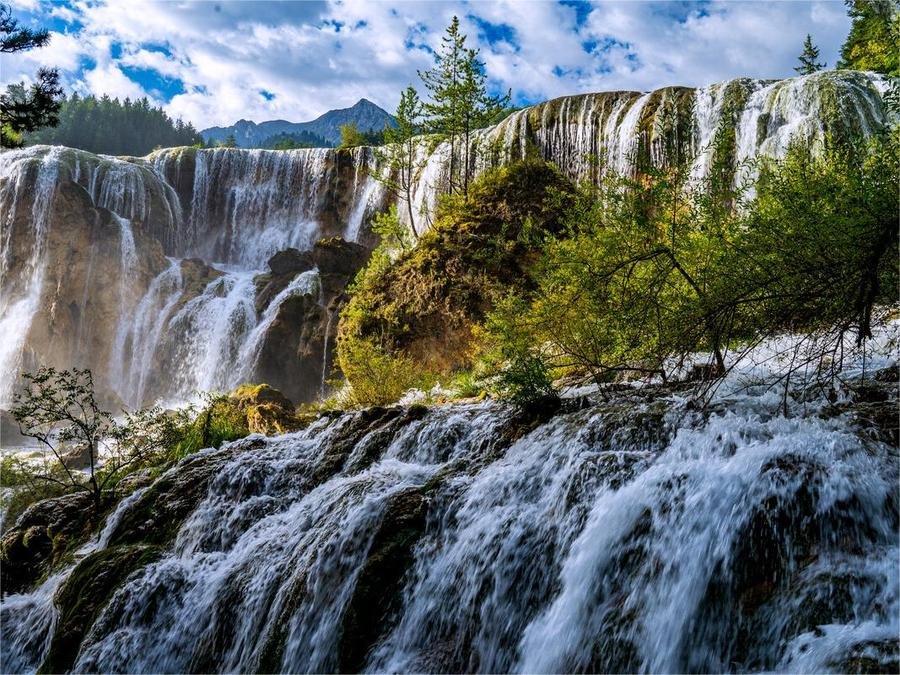
Pearl Shoal Waterfall, situated at an elevation of 2,433 meters, is a magnificent sight with a height of 21 meters and a width of 270 meters. The waterfall originates from a Quaternary glacial moraine terrace, which has been solidified by calcium deposits, creating a robust and elevated slope. The water cascades down the crescent-shaped cliff with a thunderous roar, producing a spectacular display. This area is also known for its high concentration of negative oxygen ions, earning it the nickname “natural oxygen bar.” The refreshing air and the invigorating sound of the waterfall make it a rejuvenating spot for visitors.
Pearl Shoal (珍珠滩)

Pearl Shoal, located at an altitude of 2,450 meters, spans 112.3 meters in width and 189 meters in length with an average slope of 20 degrees and a relative height difference of 15 meters. It is the widest shoal in Jiuzhaigou, formed by a large calcium carbonate deposition platform. The rushing water flows over the uneven shoal surface, creating numerous sparkling droplets in the sunlight. These water droplets resemble countless white pearls, glistening brightly and thus giving the shoal its name. The sight of these shimmering “pearls” against the backdrop of lush greenery and blue skies is truly enchanting.
Nuorilang Waterfall (诺日朗瀑布)
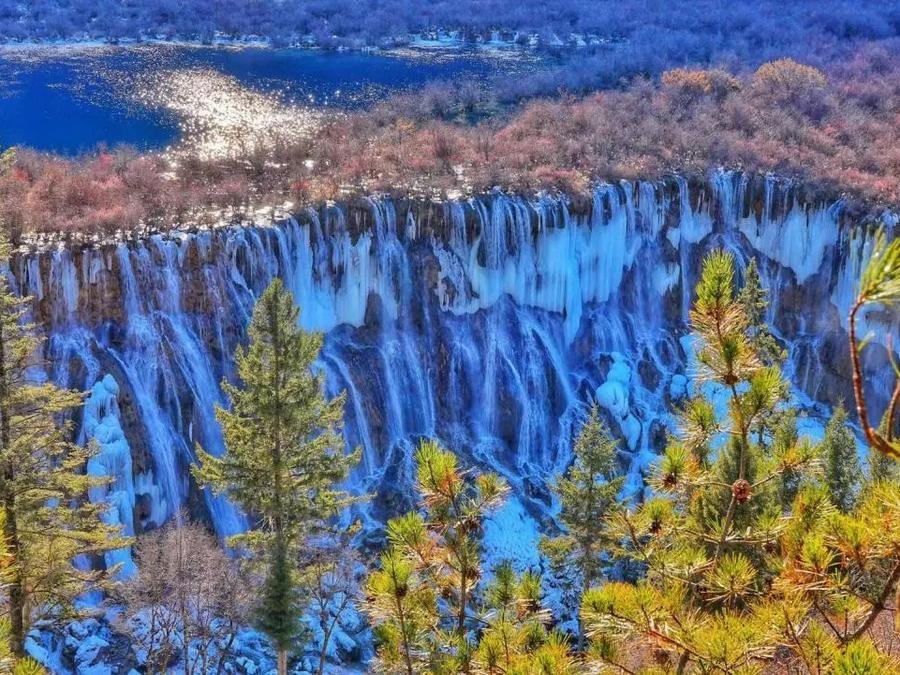
Nuorilang Waterfall, at an elevation of 2,343 meters, stands 24.5 meters high and 320 meters wide, making it the widest highland calcified waterfall in China. The name “Nuorilang” is derived from Tibetan, meaning “majestic and magnificent.” The waterfall is fed by the Nuorilang Lakes and cascades down from the forested top, creating a series of white veils that resemble the traditional Tibetan scarves known as “Hadas.” The powerful flow and the echoing sound of the water tumbling down the cliffs are awe-inspiring.
During winter, Nuorilang Waterfall transforms into a breathtaking ice spectacle. The falling water freezes, forming a massive ice curtain adorned with numerous icicles hanging from the cliffs. This unique phenomenon, known as “blue ice,” is one of Jiuzhaigou’s six great wonders. The ice sculptures, with their varying shapes and sizes, glisten under the sunlight with a subtle blue hue, creating an otherworldly and magical scene.
Nuorilang Lakes (诺日朗群海)
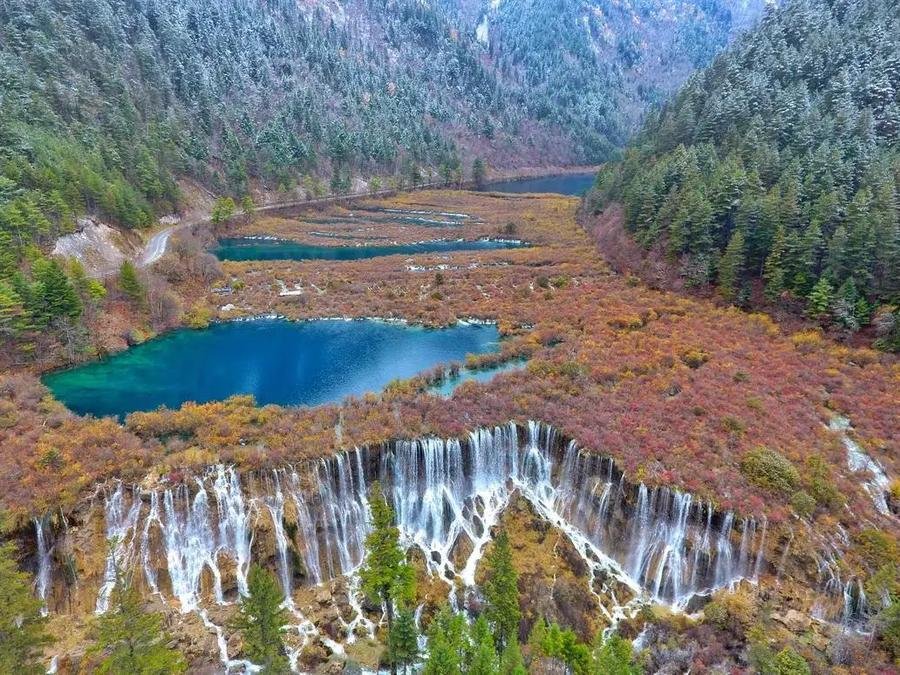
The Nuorilang Lakes, situated between 2,353 and 2,365 meters above sea level, consist of around 20 calcium-rich lakes. These lakes, collectively covering an area of approximately 0.03628 square kilometers, exhibit remarkable calcification and erosion phenomena. The lakes are distributed closely together over a span of more than 400 meters, each varying in size, shape, and depth. The largest lake measures 185 meters in length and 45 meters in width, while the smallest is 20 meters long and 15 meters wide. The depths of these lakes generally range from 7 to 20 meters, with the deepest reaching up to 23 meters. The formation of these lakes is similar to that of tufa barriers and travertine pools, resulting in their picturesque and vibrant colors. The interconnected nature of the lakes, combined with their diverse forms, creates a mesmerizing mosaic of aquatic beauty.
Panda Lake Waterfall (熊猫海瀑布)

Panda Lake Waterfall, also known as High Waterfall, is one of the most dramatic waterfalls in Jiuzhaigou. Positioned at an altitude of 2,574 meters, this waterfall boasts a height of 65 meters and a width of 75 meters, making it the tallest waterfall in the park in terms of drop. The waterfall cascades in three distinct tiers, creating a dynamic and powerful visual spectacle. During the wet season, the upstream flow exceeds the leakage rate, causing the lake to overflow and form the waterfall. In contrast, during the dry season, the waterfall often dries up, leaving behind natural ice sculptures at its base. The seasonal variations in water flow and the subsequent transformation of the landscape add to the waterfall’s allure.
Panda Lake (熊猫海)

Panda Lake, located at an elevation of 2,574 meters, is a glacial moraine-dammed lake named after the giant pandas that historically inhabited the area. The lake stretches 670 meters in length and varies in width from 109 to 237 meters, with an average depth of 15.6 meters and a total water volume of 1.8 million cubic meters. Panda Lake’s water level fluctuates seasonally, with a variation range of 5 to 7 meters. During the wet season, the lake overflows, giving rise to the spectacular Panda Lake Waterfall. In the dry season, the receding water reveals extensive golden calcified beaches along the shores. The lake is also known for its population of Jialing Fish (Schizothorax prenanti), which are often seen frolicking in the clear waters, providing an additional natural attraction.
Five-Flower Lake (五花海)

Five-Flower Lake, situated at an altitude of 2,462 meters, is one of the most colorful and mesmerizing lakes in Jiuzhaigou. The lake spans 450 meters in length, 313 meters in width, and reaches a depth of 9 meters. It is a landslide and debris flow-dammed lake, originally formed by glacial activity blocking a valley. The vibrant colors of Five-Flower Lake are due to the combination of calcium deposits, algae, aquatic plants, and submerged trees on the lakebed. These elements reflect and refract light differently, creating a kaleidoscope of colors including pale yellow, emerald green, dark green, sky blue, deep blue, and indigo. Additionally, the reflections of the blue sky, white clouds, green grasses, and lush forests further enhance the lake’s spectacular palette. When viewed from above, the lake’s array of colors resembles the spread tail of a peacock, earning it the nickname “Peacock Lake.”
Peacock Riverway (孔雀河道)
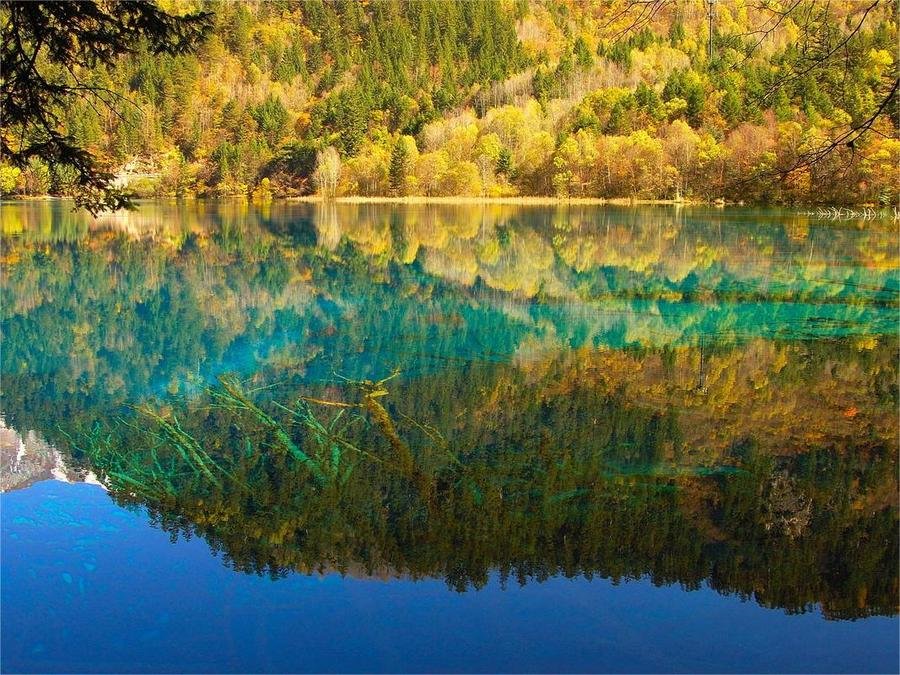
The Peacock Riverway flows out from the Five-Flower Lake’s outlet into a deep gorge. This riverway is renowned for its vibrant and dynamic coloration, resembling the brilliant feathers of a peacock. The intense blues and greens blend seamlessly, creating an impression akin to walking through a painting created with the richest hues. The interplay of colors in the Peacock Riverway is one of nature’s most beautiful spectacles, as it combines the finest shades of blue and green found in the natural world.
Arrow Bamboo Lake (箭竹海)

Arrow Bamboo Lake, located at an altitude of 2,629 meters, is another jewel of Rize Valley. The lake is 1,184 meters long, 144 to 268 meters wide, and 5 to 10 meters deep, covering an area of 151,000 square meters with a water volume of 930,000 cubic meters. It is sustained by a stable underground water source, resulting in minimal annual water level variation and preventing it from freezing during winter. The lake is named after the arrow bamboo (Fargesia nitida) that thrives around its shores. On calm days, the lake’s surface reflects the surrounding bamboo and forest, creating an enchanting mirror effect. The stillness of the water combined with the vivid green of the bamboo makes for a serene and picturesque landscape.
Swan Lake (天鹅海)
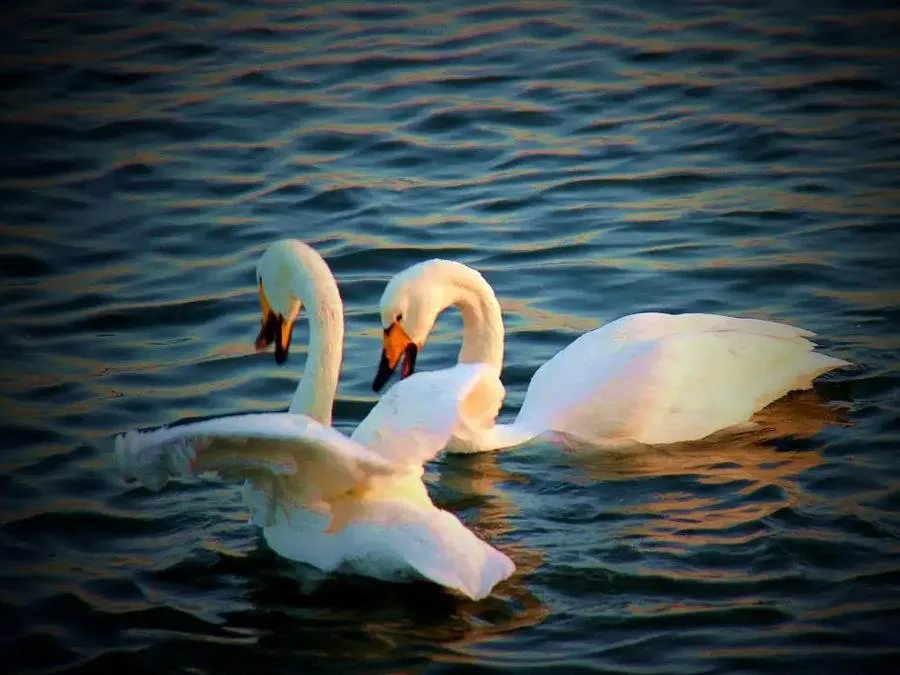
Swan Lake, situated at an altitude of 2,905 meters, is a picturesque marsh lake known for its tranquil beauty and occasional visits by swans. The lake stretches 720 meters in length and varies in width from 50 to 100 meters, with depths ranging between 2 to 6 meters. Covering an area of 43,000 square meters and holding a water volume of 200,000 cubic meters, Swan Lake is a serene spot where green meadows extend into shallow waters. The lake’s surface is often dotted with swans, adding to its ethereal charm. A clear stream winds through the lush greenery of the meadow, nurturing the surrounding flora and creating a peaceful, almost dreamlike landscape. The lake’s connection to the downstream Grass Lake enhances its ecological significance, providing a vital link in the valley’s hydrological system.
Grass Lake (芳草海)

Grass Lake, located at an elevation of 2,910 meters, is another marsh lake in Rize Valley. This lake is 540 meters long, 4 to 20 meters wide, and 2 to 4 meters deep, with an area of 50,000 square meters and a water volume of 10,000 cubic meters. Grass Lake primarily receives water from upstream streams and precipitation, and its lakebed is dotted with calcium carbonate funnels. Each season brings its own unique beauty to Grass Lake. In spring, the area is lush with green grass, while summer sees the meadow adorned with vibrant flowers. Autumn transforms the landscape with golden hues, and winter blankets the area in pristine white snow. This seasonal diversity makes Grass Lake a dynamic and ever-changing natural wonder, offering visitors a variety of picturesque scenes throughout the year.
Primeval Forest (原始森林)
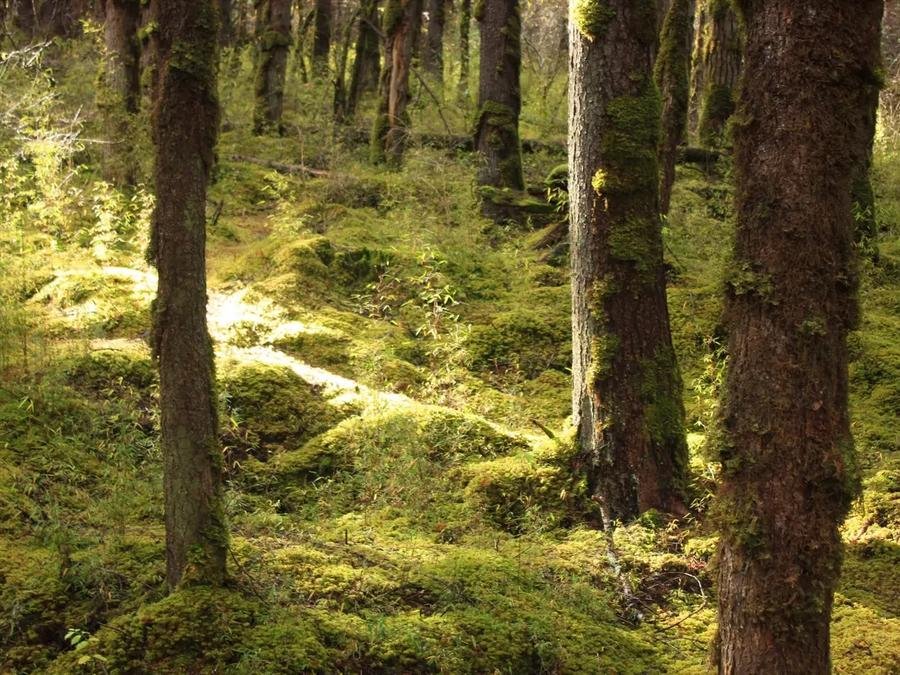
The Primeval Forest in Rize Valley is a captivating area located at an altitude of 2,930 meters. Dominated by ancient fir and spruce trees, some of which are several hundred to a thousand years old, the forest is a testament to the enduring power of nature. The understory is rich with shrubs such as honeysuckle, rhododendron, arrow bamboo, and rowan, while the forest floor is carpeted with thick moss layers, some reaching several centimeters in depth. The forest boasts a remarkably high concentration of negative oxygen ions, reaching up to 3,000 per square centimeter, earning it the title of a “natural oxygen bar.” The presence of lichens in the forest further underscores the purity of the air, as lichens can only thrive in environments free from pollution. Walking through this ancient forest, visitors can experience the pristine air quality and the untouched beauty of Jiuzhaigou’s natural environment.
Zharu Valley (扎如沟)
Zayizhaga Sacred Mountain (扎依扎嘎神山)
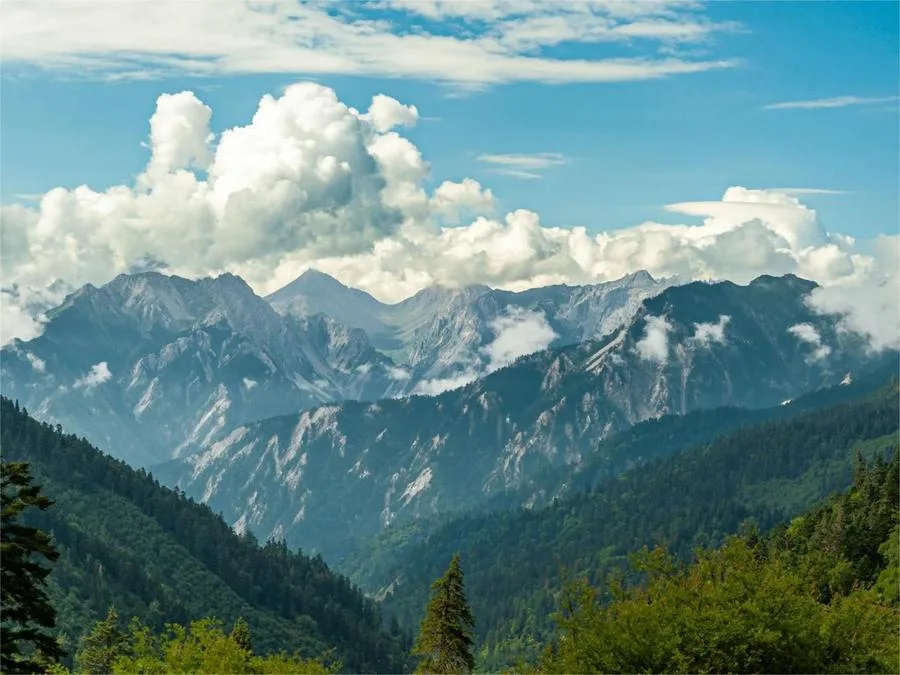
Rising majestically to an elevation of 4,528 meters, Zayizhaga Sacred Mountain is revered as the king of all mountains by the local residents. This spiritual landmark stands at the end of the Zharu horse trail and serves as a focal point for religious activities. According to local belief, Zayizhaga is the supreme mountain deity, commanding deep respect and veneration from the community. Pilgrimages around the mountain, conducted on the fifteenth day of each lunar month and particularly during the Mazhi Festival on the fifteenth day of the third lunar month, draw scores of devotees. Pilgrims travel in large groups, some on horseback and others on foot, circling the mountain in a counterclockwise direction while praying for blessings from the gods.
Black Lake (黑海)

Black Lake, known in Tibetan as Cuola, covers an area of approximately five acres and reaches depths of up to eight meters, making it a significant example of a cirque lake. This lake holds a unique place in local lore; during droughts, Tibetan villagers would come to Black Lake to pray for rain. The lake is often shrouded in low clouds, and it is said that shouting towards the clouds would cause rain to fall. In the summer, the area around Black Lake is a verdant grassland, providing a stark contrast to the snowy landscape that blankets the region in winter. This seasonal transformation makes Black Lake a place of continual natural beauty and cultural importance.
Mirror Cliff (宝镜岩)

Mirror Cliff is a geological wonder formed through differential movement of the earth’s crust and landslides triggered by earthquakes. The cliff stands with a vertical relief of up to 500 meters, creating a large, flat rock face. The smooth surface of Mirror Cliff reflects rich images of people and objects, earning it the name “Mirror.” This natural formation is a striking feature of Zharu Valley, offering visitors an impressive spectacle of geological history and natural artistry.
Zharu Monastery (扎如寺)

Perched at an altitude of 2,026 meters, Zharu Monastery, known in Tibetan as Rengong Gongba, is the only religious temple within the Jiuzhaigou Scenic Area. Founded in the late Ming Dynasty, the monastery has undergone two major renovations. It stands as a spiritual sanctuary for followers of the Bon religion, which predates Buddhism in Tibet. Surrounded by towering mountains and facing the imposing Mirror Cliff, Zharu Monastery is a site of serene beauty and profound religious significance. The golden roof and red eaves of the monastery, along with the fluttering five-colored prayer flags, create a vivid representation of Bon culture. The monastery hosts four major religious festivals each year, with the grandest being the Mazhi Festival on the fifteenth day of the fourth lunar month.
Video about Jiuzhai Valley
Empfohlene eintägige Reiseroute
9:00 – 12:00: Morning Exploration
- 9:00: Start the day by taking a sightseeing car to Arrow Bamboo Lake. Enjoy the scenery and take a roughly 700-meter walk to the boarding point for the car.
- 10:00: Board the car to Five Flower Lake. Spend some extra time at this beautiful spot before boarding the car again.
- 11:00: Continue the journey to Pearl Shoal Waterfall (a filming location for Journey to the West). Take a walk to the Jinghai station and board the car.
- 12:00: Arrive at Nuorilang Service Station for lunch.
12:00 – 13:00: Lunch and Rest Time
13:00 – 15:00: Afternoon Exploration – Left Side of Y Shape
- 13:00: Board the car at Nuorilang Service Station and head towards Changhai station. Disembark at Changhai Station, where you can see snow-capped mountains.
- 13:30: Take a 1000-meter walk to reach Five Color Pond. Board the car again at the Five Color Pond boarding point.
- 14:00: Continue the journey to Nuorilang Service Station. Opt to sit on the right side of the sightseeing car to enjoy the scenic views along the way.
15:00 – 17:30: Continued Exploration
- 15:00: Walk to Nuorilang Waterfall and board the car at the boarding point.
- 15:30: Take the car to Shuzheng Village. Upon arrival, you’ll find Shuzheng Village on the left and Shuzheng Waterfall on the right. Purchase Tibetan barley tea from a small shop near the waterfall and enjoy it while sitting on the open terrace, taking in the waterfall’s beauty.
- 16:30: Board the car to Penjing Beach Station. Walk about 500 meters to reach Reed Sea, then walk back to the Penjing Beach Station and board the car.
- 17:00: Take the car to the mouth of the valley.
Nützliche Tipps aus echten Rezensionen
Geographic Layout:
- Jiuzhai Valley has a Y-shaped distribution. Shuzheng Valley is at the bottom, Zechawa Valley is on the left, and Rize Valley is on the right. The left side has fewer attractions, mainly Long Lake and Five-Color Pond, while the highlights are concentrated on the right and bottom.
Suggested Itinerary:
- Start your visit in the morning by taking a bus to the primeval forest and explore the park from top to bottom.
- Have lunch at the Nuorilang Center Station around noon.
- Spend the afternoon exploring the attractions on the left and bottom side of the valley, then return to the park entrance.
Transportation:
- The park is vast, so if there are sightseeing cars available, it’s recommended to use them to save time. Walking might not be sufficient to cover the entire area in a limited time.
Nuorilang Center:
- There is only one place to eat within Jiuzhai Valley, the Nuorilang Center. It offers a variety of dining options, including buffet, boxed meals, instant noodles, etc.
- The facilities are well-equipped, and the toilets are reported to be clean. This area is also the only designated smoking area within the park.
Attractions near Jiuzhai Valley

Mounigou-Tal

Diexi SongpingGou Tal

Huanglong - Gebiet von landschaftlichem und historischem Interesse

Songpan Ancient Town
Attraktionen in Aba, Sichuan-Landschaft, Tibetisches Gebiet Sichuan, UNESCO-Welterbestätte